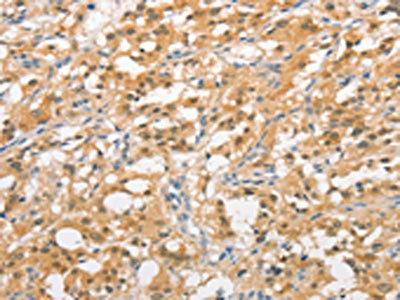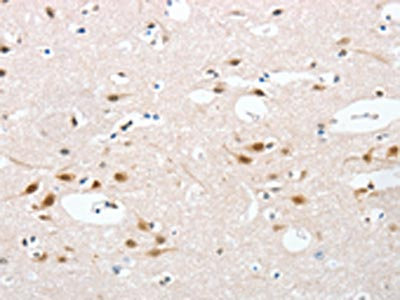UBQLN1 Antibody
-
中文名稱:UBQLN1兔多克隆抗體
-
貨號:CSB-PA945911
-
規(guī)格:¥1100
-
圖片:
-
The image on the left is immunohistochemistry of paraffin-embedded Human thyroid cancer tissue using CSB-PA945911(UBQLN1 Antibody) at dilution 1/20, on the right is treated with fusion protein. (Original magnification: ×200)
-
The image on the left is immunohistochemistry of paraffin-embedded Human brain tissue using CSB-PA945911(UBQLN1 Antibody) at dilution 1/20, on the right is treated with fusion protein. (Original magnification: ×200)
-
-
其他:
產品詳情
-
Uniprot No.:
-
基因名:
-
別名:DA41 antibody; DSK2 antibody; FLJ90054 antibody; hPLIC-1 antibody; hPLIC1 antibody; PLIC-1 antibody; PLIC1 antibody; Protein linking IAP with cytoskeleton 1 antibody; Ubiquilin-1 antibody; Ubiquilin1 antibody; UBQL1_HUMAN antibody; UBQLN1 antibody; UBQN antibody; XDRP1 antibody
-
宿主:Rabbit
-
反應種屬:Human,Mouse,Rat
-
免疫原:Fusion protein of Human UBQLN1
-
免疫原種屬:Homo sapiens (Human)
-
標記方式:Non-conjugated
-
抗體亞型:IgG
-
純化方式:Antigen affinity purification
-
濃度:It differs from different batches. Please contact us to confirm it.
-
保存緩沖液:-20°C, pH7.4 PBS, 0.05% NaN3, 40% Glycerol
-
產品提供形式:Liquid
-
應用范圍:ELISA,IHC
-
推薦稀釋比:
Application Recommended Dilution ELISA 1:2000-1:5000 IHC 1:25-1:100 -
Protocols:
-
儲存條件:Upon receipt, store at -20°C or -80°C. Avoid repeated freeze.
-
貨期:Basically, we can dispatch the products out in 1-3 working days after receiving your orders. Delivery time maybe differs from different purchasing way or location, please kindly consult your local distributors for specific delivery time.
-
用途:For Research Use Only. Not for use in diagnostic or therapeutic procedures.
相關產品
靶點詳情
-
功能:Plays an important role in the regulation of different protein degradation mechanisms and pathways including ubiquitin-proteasome system (UPS), autophagy and endoplasmic reticulum-associated protein degradation (ERAD) pathway. Mediates the proteasomal targeting of misfolded or accumulated proteins for degradation by binding (via UBA domain) to their polyubiquitin chains and by interacting (via ubiquitin-like domain) with the subunits of the proteasome. Plays a role in the ERAD pathway via its interaction with ER-localized proteins UBXN4, VCP and HERPUD1 and may form a link between the polyubiquitinated ERAD substrates and the proteasome. Isoform 1, isoform 2 and isoform 3 play a role in unfolded protein response (UPR) by attenuating the induction of UPR-inducible genes, DDTI3/CHOP, HSPA5 and PDIA2 during ER stress. Involved in the regulation of macroautophagy and autophagosome formation; required for maturation of autophagy-related protein LC3 from the cytosolic form LC3-I to the membrane-bound form LC3-II and may assist in the maturation of autophagosomes to autolysosomes by mediating autophagosome-lysosome fusion. Negatively regulates the TICAM1/TRIF-dependent toll-like receptor signaling pathway by decreasing the abundance of TICAM1 via the autophagic pathway. Isoform 1 and isoform 3 play a key role in the regulation of the levels of PSEN1 by targeting its accumulation to aggresomes which may then be removed from cells by autophagocytosis. Promotes the ubiquitination and lysosomal degradation of ORAI1, consequently downregulating the ORAI1-mediated Ca2+ mobilization. Suppresses the maturation and proteasomal degradation of amyloid beta A4 protein (A4) by stimulating the lysine 63 (K63)-linked polyubiquitination. Delays the maturation of A4 by sequestering it in the Golgi apparatus and preventing its transport to the cell surface for subsequent processing.
-
基因功能參考文獻:
- Thus, UBQLN1 plays an important role in clearing mislocalized mitochondrial proteins upon cell stimulation, and its absence leads to suppression of protein synthesis and cell cycle arrest. PMID: 28933694
- UBQLN1 variant was not associated with the risk of Alzheimer's disease. PMID: 28719358
- The STI and UBA Domains of UBQLN1 Are Critical Determinants of Substrate Interaction and Proteostasis. PMID: 28075048
- Following the loss of UBQLN1 in lung adenocarcinoma cells, there is an accelerated loss of IGF1R. PMID: 29054976
- The evidence of genetic associations has been found for the multivariate response phenotype that involves trans effects modulating expression of genes following heat shock, including HSF1 and UBQLN1. PMID: 27553423
- The expression level of UBQLN1 and prognosis in breast cancer is clarified for the first time and UBQLN1 seems to be a novel molecular marker to predict poor prognosis in breast cancer. PMID: 26406952
- The results suggest that UBQ-8i polymorphism may contribute to Alzheimer's disease susceptibility, but does not synergize with APOEepsilon4 status to increase Alzheimer's disease risk. PMID: 25010605
- These results suggest that the UBQ-8i polymorphism is associated with Alzheimer's disease risk. PMID: 25387430
- found that ZEB1 is required for induction of mesenchymal-like properties following loss of UBQLN1 and ZEB1 is capable of repressing expression of UBQLN1 PMID: 24747970
- High UBQLN1 expression is associated with low radiosensitivity in breast cancer. PMID: 25044403
- Ubiquilin-1 immunoreactivity is concentrated on Hirano bodies and dystrophic neurites in Alzheimer's disease PMID: 23421764
- Human ubiquilin-1 overexpression in transgenic mice increases the lifespan and delays accumulation of Huntingtin aggregates in the R6/2 mouse model of Huntington's disease. PMID: 24475300
- The results demonstrate that in Alzheimer's disease hippocampus, ubiquilin-1 immunoreactivity increases in the neuronal nucleoplasm and is associated with region-specific neurofibrillary changes. PMID: 23869942
- Targeting of Ubqln1 to autophagosomes requires the Ubqln4 UBL domain and the Ubqln1 UBA domain. PMID: 23459205
- data suggest that ubiquilin-1 modulates gamma-secretase-mediated epsilon-site cleavage and thus may play a role in regulating gamma-secretase cleavage of various substrates. PMID: 23663107
- Genetic variants in UBQLN1 are not commonly associated with amyotrophic lateral sclerosis PMID: 22766032
- This study demonistrated that Allele C of polymorphism UBQ-8i of the UBQLN1 gene is not an independent risk factor for mild cognitive impairment or Alzheimer's disease PMID: 22272618
- Ubiquilin-1 was over-expressed following antiproliferative agents treatment of ovarian cancer cells. PMID: 22134777
- ubiquilin-1 chaperone activity is necessary to regulate the production of APP and its fragments and that diminished ubiquilin-1 levels may contribute to AD pathogenesis. PMID: 21852239
- PLIC-1 is a novel inhibitor of the TLR3-Trif antiviral pathway by reducing the abundance of Trif PMID: 21695056
- specific ubiquilin-1 transcript variants can cause PS1 accumulation and aggresome formation PMID: 21143716
- Data show that ubiquilin is degraded during both macroautophagy and during chaperone-mediated autophagy (CMA). PMID: 20529957
- The UBQ-8i polymorphism of the UBQLN1 gene is extremely rare in Taiwan Chinese and unlikely to play a significant role in the risk of AD in Taiwan Chinese. PMID: 20350585
- PLIC1 may be a regulator of HCV RNA replication through interaction with NS5B. Nn Huh7 cells that express an HCV subgenomic replicon, the amounts of both NS5B and the replicon RNA were reduced by overexpression of PLIC1. PMID: 12634373
- Ubiquilin proteins play an important role in regulating PS protein levels in cells. PMID: 15004330
- Ubiquilin-1 plays an active role in the precise regulation of HASH-1 and of other tissue-specific bHLH proteins PMID: 15492808
- Our findings suggest that genetic variants in UBQLN1 on chromosome 9q22 substantially increase the risk of Alzheimer's disease, possibly by influencing alternative splicing of this gene in the brain PMID: 15745979
- ubiquilin-1 limits the availability of unassembled nicotinic acetylcholine receptor subunits in neurons by drawing them to the proteosome, thus regulating nicotine-induced up-regulation PMID: 16091357
- Genetic variation in the UBQLN1 gene has a modest effect on risk, age of onset and disease duration of Alaheimer's disease. PMID: 16302009
- Overexpression of ubiquilin reduces cell death in HeLa cells and primary neurons stably expressing green fluorescent protein-huntingtin fusion protein. PMID: 16461334
- Results suggest that UBQLN1 variants do not increase risk for Alzheimer disease. PMID: 16526030
- Data show that ubiquilin 1 interacts both with presenilin 1 (PS1) holoprotein and heterodimer and that the interaction between PS1 and ubiquilin 1 takes place near the cell surface. PMID: 16815845
- UBQLN1 modulates amyloid precursor protein trafficking and Abeta secretion. PMID: 16945923
- These results indicate a role for PLIC-1 in the protein aggregation-stress pathway, and we propose a novel function for the ubiquitin-like (UBL) domain--by means of UBL-UIM interactions--in transport to aggresomes. PMID: 17082820
- Mutation of two lysine residues in the PS2-loop region suggested that ubiquitination is not required for interaction with ubiquilin-1 and may, in fact, even negatively regulate the interaction. PMID: 17614368
- Our results suggest that it is unlikely that the SNP rs12344615 of the UBQLN1 gene is related to the onset of AD, PD or cognitive function. PMID: 17709205
- Expression of the human Alzheimer's disease-associated variant of UBQLN1 leads to more severe degeneration than does comparable expression of the human wildtype UBQLN1 in Drosophila eye. PMID: 17947293
- The three-dimensional structure of the UBA domain of ubiquilin-1 (UQ1-UBA) free in solution and in complex with ubiquitin, is described. PMID: 18241885
- Risk estimation for AA versus GG genotypes showed that the AA genotype is a weak risk factor for Alzheimer's disease PMID: 18340109
- Plic-1 may play a significant role in regulating the strength of synaptic inhibition by increasing the stability of GABA(A)Rs within the secretory pathway and thereby promoting their insertion into the neuronal plasma membrane. PMID: 18467327
- overexpression UBQLN1 transcript variants TV1-3, but not TV4, exert a protective effect during the unfolded protein response by attenuating CHOP induction and potentially increasing cell viability. PMID: 18953672
- siRNA-mediated UBQLN1 depletion made cells more susceptible to starvation-induced cell death. UBQLN1 regulates cell survival during starvation. PMID: 19148225
顯示更多
收起更多
-
亞細胞定位:Cytoplasm. Nucleus. Endoplasmic reticulum. Cytoplasmic vesicle, autophagosome. Cell membrane.
-
組織特異性:Brain (at protein level). Ubiquitous. Highly expressed throughout the brain; detected in neurons and in neuropathological lesions, such as neurofibrillary tangles and Lewy bodies. Highly expressed in heart, placenta, pancreas, lung, liver, skeletal muscle
-
數(shù)據(jù)庫鏈接:
Most popular with customers
-
-
YWHAB Recombinant Monoclonal Antibody
Applications: ELISA, WB, IHC, IF, FC
Species Reactivity: Human, Mouse, Rat
-
Phospho-YAP1 (S127) Recombinant Monoclonal Antibody
Applications: ELISA, WB, IHC
Species Reactivity: Human
-
-
-
-
-





















